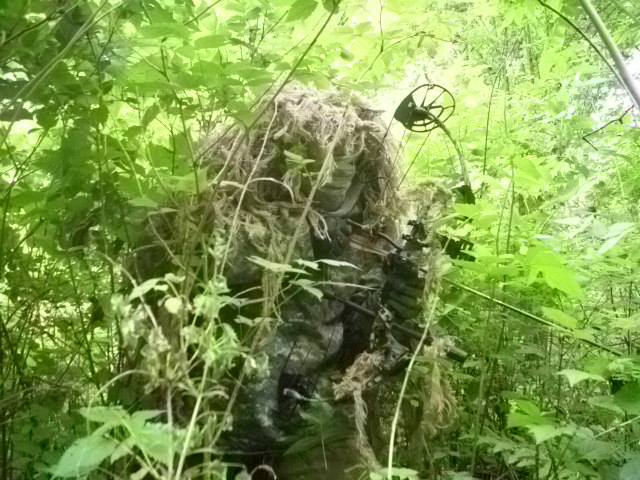
by Deep Green Resistance News Service | Jun 7, 2017 | Direct Action
Editor’s note: This article is adapted from a training held last May 13-14 at the Shxwowhamel First Nation.
by Sakej Ward
Individual Operational Readiness
Do you have an impact on the “battlefield” or are you a liability? Do you possess a wide range of activist’s conflict skills? Are your skills up to speed? Not all activists are created equal.
The come-as-you are activist, the person who shows up at crisis events with intent to engage in obsolete, ineffectual, passive tactics that requires so very little skill and equipment (gear) is an amateur who treats the struggle for justice more as a social gathering (a crisis pow wow with endless opportunities to get selfies) than a war.
On the “Battlefield” good intentions, thoughts and prayers are not enough.
The opposition (the colonial government and its industries of destruction) are deadly serious about counter-activism operations. They see it as a war to protect their vast power and privilege. They see it and treat it like a war. They go to great lengths to plan, prepare, mobilize, equip, deploy and release their dogs of war upon the people.
The gap of capability (including skills and gear) between the activists and the government is immense but it doesn’t have to be. Activists can reduce this capability-gap by training in their particular skill sets and acquiring, modifying and training on the proper highly-specialized gear to get those tasks done in a highly efficient manner.
Skills and gear empower the strategy.
The come-as-you are activist, showing up with little to no skills to conduct critical actions and little to no mission essential gear to pull them off need to take their engagement in “battle” much more serious. They need take more responsibility for their commitment to justice if they want to be of real help.
Your commitment to justice is measured by your willingness to put in the necessary time, effort, resources and sacrifices to make yourself a better weapon of justice.
Activists need to become “Become the Weapon” by becoming Operational Ready in order to be of real help at crisis situations.
Operational Ready consist of two main factors; skills to complete your mission and the gear to fulfill it.
Skills
To be operation-ready for a crisis situation, activists need to determine skills needed to conduct their type of actions. Most activists have no advanced thinking about what kind of assistance he/she will provide or what type of skills their assistance may require.
Developing skills sets starts with creating a training plan. Establishing a training plan begins with an analysis of doctrine, operations (campaigns), missions (actions), tasks and skills.
Activists should start by determining their doctrine (how they fight). The activist’s doctrine may be passive legal, it can be civil disobedience, or the doctrine may be direct.
Next determine the type of operations (campaigns) that are common to those doctrines. It is important to make as complete of a list of common operations (campaigns). These can be operations that are normally conducted by the activist or operations the activist feels his/her doctrine would call for. It would also be wise to realistically anticipate trends towards upcoming new types of conflicts and operations the activists may engage in the near future.
Identifying operations (campaigns) aren’t just about identifying the issue in contention. It’s about identifying the objectives used to successfully complete those operations. For example, an activist participating in Indigenous justice may engage in a Murder and Missing Indigenous Women Campaign (operation). The objective of the operation (campaign) might be to raise awareness of the issue or to bring those responsible to justice. Identifying the objective may generate some ideas on new or unused tactics for specific operations.
After all the operations (campaigns) have been identified the list needs to be broken down further by determining a full range of missions (actions) in those operations (campaigns).
So, an operation (campaign) to save a forest, for activists with a doctrine of civil disobedience, may include missions (actions) like setting up a blockade on a logging road or chaining themselves to a tree while activists with a doctrine of Direct Action may include missions (actions) like taking out a piece of heavy equipment or taking down a bridge on a logging road. The operation is the same but the doctrine creates a different set of mission profiles.
Once a full range of operations and the missions utilized in those operations are identified, then determine the tasks that are necessary to complete those missions (actions). A blockade mission (action) would require tasks like shutting down traffic on a road, barrier construction, interacting with people, interacting with police, interacting with media, guard duty, tactical observation, tactical communications, etc. Some of these skill sets are team skills (stopping a vehicle) and some are individual skills (rolling out barbed wire). Separate the two skills sets (team and individual) involved in those actions. Training plans should be a sequential development of skill sets from individual skills up to team based skills.
In addition to identifying individual skills of these skill sets, determine the standards for those skills. Standards are the level of quality expected for the skill sets. Being able to execute a skill in a poor manner like making several mistakes, taking a very long time to execute it, only can execute the skill with help from references (people, books, videos, etc), can’t do it in the dark or under pressure all ensure failure when it comes time to execute these skills in a crisis situation. Skills need to be practiced to certain level; a standard that reflects the conditions of the actions you will be in. For instance – assigning a standard to applying a first aid pressure dressing should include executing it properly (without mistake), in a designated time, possibly with improvised items, in the dark, in field conditions while under stress. Every skill needs to have a standard assigned to it as a way of establishing the level of training and as a testable condition.
Assemble all the skills and arrange them in blocks of training (like first aid, tactical communications, self defense, etc.). Determine the required sequence of instructing these skills. Some skills require knowing a prior skill first, for example – in order to send a radio message activists would first need to know how to put a specific radio into operation. Assign a timeline to instruct, practice and test each skill. This timeline influences the development of your training schedule.
Finalize the training plan by identifying instructors for each of the skill sets, training areas, training facilities, reference materials, training budgets, and training aids.
Gear
- Identify common gear needed that best fits all the tasks. This is the kind of gear that will be used in most or all crisis situation such as backpack, sleeping bag, sleeping pad, wet weather gear, warm gear, multi-tool, Individual first aid kit, survival kit, etc.
- Identify mission specific gear. This is gear that is specific to the identified missions. It can be barrier construction tools, observation tools, breaching tools, safety equipment, etc.
- Select gear for those actions. Determine the best gear for the task based on a few factors;
Selection Factors
- Cost – We would all love to have the newest, most high tech tactical gear around but cost becomes the barrier to this. Select gear based on a priority list of critical and mission-essential gear first.
- Availability – You may want it but it isn’t available, for whatever reason, to you. Determine good substitutions.
- Quality – much of the gear should be excellent quality because your life or liberty may depend on it. Some gear isn’t as crucial like a rain jacket. Does it need to be the best rain jacket from a high-end store or does it just have to get the job done? There is also good quality used gear for sale, as long as you know what to look out for. Set standards for what you need in your gear before buying.
- Durability – The gear will be used under the worst conditions so don’t expect cheap dollar store gear to hold up under field conditions. Should be simple but rugged.
- Multi-purpose – finding gear that can be used for more than one task increases its value.
- SAWC – Size And Weight Consideration. Sometimes good gear is large, bulky, and heavy and impedes mobility. Look for gear that is as compact, light but still functional for the tasks.
- Camouflage pattern – Bright shiny items attract the eye and can give you away. Determine the best camouflage pattern for the area of operation.
- Waterproof – it will rain in the field so gear needs to be water proof.
- Shockproof – it will be dropped, kicked, sat on, thrown across the room in frustration (or at a threat) but it still needs to function after its abuse.
- Simplicity – the more high tech or the more moving parts invites breakdown. Try to select gear that is simple and robust.
- Best achieves the mission – the main purpose of the gear is to assist in successful completion of missions (actions). That should stay in the forefront of the activist’s mind. When choosing between two possible pieces of gear, determine which best assist in achieving the mission.
- Ergonomic – the gear should be both efficient and comfortable. This extends the time frame for use in work. An uncomfortable or inefficient piece of gear will wear down the activist earlier, making work harder.
The best gear isn’t always the most expensive, coolest looking (tacti-cool), widest advertised or what some other person or group is using. If there are any questions on gear determination or gear selection consult an experienced freedom fighter that is a subject-matter-expert in the use of gear as well as the procurement of gear for specific kinds of operations and missions.
Once a training plan is developed and the gear is obtained the activist needs to train to standard on the skills and with the gear obtained in order to properly fit, modify, personalize and familiarize with that gear.
When all the gear procurement and initial training is complete a series of culmination exercise (based on all the different operations and likely missions for each) should be conducted. It provides an opportunity for testing to standard and evaluating all the common and mission-essential tasks to determine if the activists are operational ready.
“Welcome to my War”
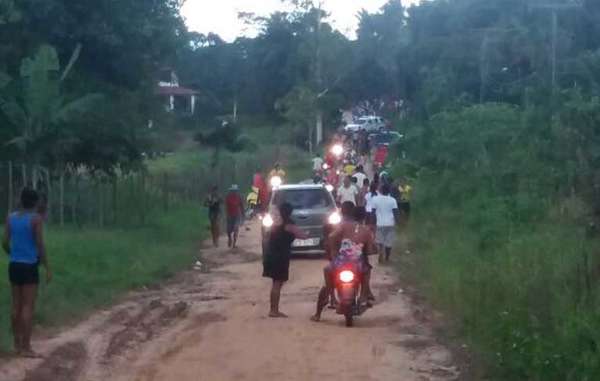
by Deep Green Resistance News Service | May 4, 2017 | Colonialism & Conquest
Featured image: Cellphone photo shows the ranchers on their way to attack the Gamela. A police car accompanies them. © CIMI
by Survival International
Warning: Graphic photos
Thirteen Brazilian Indians have been hospitalized after a brutally violent attack by men armed with machetes in the Amazon.
One man appears to have had his arms severed in disturbing photos released to Survival International.
The attack was in retaliation for the Gamela Indians’ campaign to recover a small part of their ancestral territory. Their land has been invaded and destroyed by ranchers, loggers and land grabbers, forcing the Gamela to live squeezed on a tiny patch of land. The Gamela are indigenous to the area in Maranhão state in northern Brazil.
Powerful agribusiness interests – reportedly including the Sarney landowning family – have been in conflict with the tribe for some time. The family includes a former president of Brazil and a former governor of Maranhão state.

Photo of a victim of the attack, sent to Survival by Brazilian NGO CIMI. © CIMI
Eyewitnesses say that the ranchers gathered at a barbecue to get drunk, before surrounding the Gamela camp, firing guns, and then attacking with machetes, causing grievous injuries. Local police are reported to have stood by and allowed the attack to happen.
The Gamela have received death threats in response to their attempts to return to their land. In a declaration released by Brazilian NGO CIMI, they said: “People are mistaken if they think that by killing us they’ll put a stop to our fight. If they kill us, we will just grow again, like seeds… Neither fear nor the ranchers’ bullets can stop us.”
The attack came just days after massive indigenous protests in Brazil’s capital against proposed changes to Brazil’s indigenous laws, which could have disastrous consequences for tribal peoples.
Land theft is the biggest problem tribal peoples face. Around the world, industrialized society is stealing tribal lands in the pursuit of profit.
Campaigners fear that the close ties between Brazil’s agribusiness lobby and the Temer government installed after the impeachment of Dilma Rousseff in 2016 could lead to further genocidal violence and racism against Brazilian tribal peoples.
Survival’s Director Stephen Corry said: “Right now, we’re witnessing the biggest assault on Brazilian Indians for the last two generations. This truly horrific attack is symptomatic of a sustained and brutal onslaught which is annihilating indigenous communities across the country. Heinous acts like this won’t end until the perpetrators are prosecuted and Brazil starts enforcing tribal land rights as it should do under national and international law.”
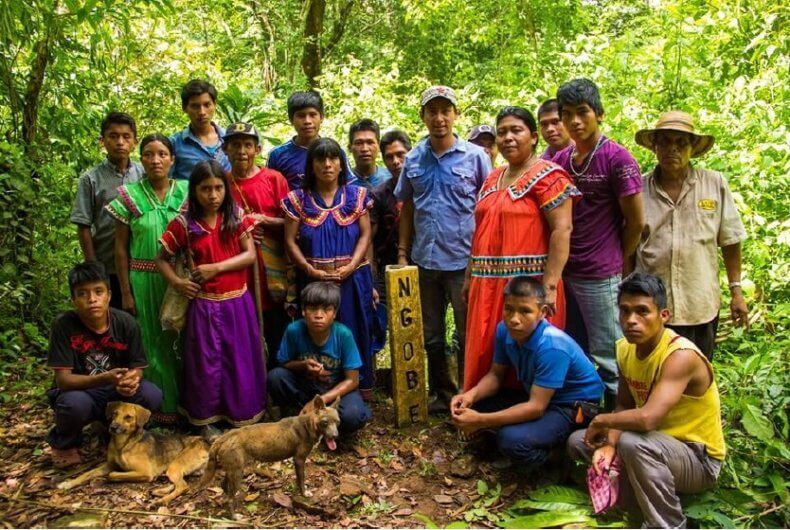
by Deep Green Resistance News Service | Apr 22, 2017 | Lobbying
Featured image: Residents of Kiad around an important boundary post for the Ngäbe people at the border of the comarca. (Photo courtesy Duiren Wagua)
Este artículo está disponible en español aquí
by Tracy Barnett / Intercontinental Cry
Cultural Community of Kiad, Panama — Members of the grassroots indigenous Ngäbe-Buglé group known as The April 10 Movement (El Movimiento 10 de Abril, or “M10”), issued a call to the international community on Wednesday. They ask for an intervention to stop Ngäbe-Buglé communities from being flooded by the Barro Blanco hydroelectric dam.
The M10 called the flooding illegal and a violation of their human rights and the UN Declaration on the Rights of Indigenous Peoples. They refer to an environmental impact statement that failed to acknowledge the presence of the three communities that would be flooded by the project. They also say the agreement that Panamanian President Juan Carlos Varela signed last August with the now-impeached leader Silvia Carrera was illegal, since it was done without the approval of the Ngäbe-Buglé General Congress, and was rejected by the congress in September.
Government representatives met with members of the group in the Cultural Community of Kiad on March 27. It was part of a series of meetings “to agree on options with respect to spaces and points of cultural veneration by communities impacted by the project and the monitoring of water quality studies,”[1] according to an institutional response from the government. Several days later, the water began to rise in the reservoir and has continued to rise until the time of publication of this communique. Community members have still not received communication from the government regarding the rising water levels or a future meeting date.
Communiqué from the April 10 Movement on the Barro Blanco hydroelectric plant
The community affected by the Hydroelectric Project Barro Blanco, hereby makes public the following facts of the violation of human rights by the Barro Blanco Dam:
1- As has been public knowledge since the beginning of the Barro Blanco project, the environmental impact study denied the existence of the original community that for centuries had lived in the confluence of the Tabasará River, and concessioning this place for the Barro Blanco hydroelectric dam has created a social, economic, cultural, spiritual, and environmental conflict for the community.
2- The government and the Supreme Court of Justice have violated the constitutional and legal precepts of our rights with the implementation of the Barro Blanco hydroelectric plant.
3- We firmly reject the ratification of the Varela-Carrera agreement for the defunct congress presided over by Demecio Case, held between 6 and 9 April 2017 in the northern community in the ñökribo region, in which agreement we played no part. Nor were we consulted about the content of the agreement, and the agreement was not accepted by the population of Llano Tugrí on August 22, 2016 and was rejected in Cerro Algodón on September 15, 2016 by the full General Congress where 148 delegates attended.
4- The highest body of expression and decision, the General Congress, has 255 elected delegates, with full right of decision and for which quorum constitutes 50% plus one; therefore the Norteño decision is illegal, since only 61 delegates attended, in addition to Mr. Demecio Case, who was removed from office on March 7, 2017, in Llano Tugrí, in the ordinary congress.
5- We request the President of the Republic to be a little more respectful of our rights, since any act carried out for the execution of said project has been done violating our legal security, and not only has violated the norms of the Republic, but also violated the Convention and the United Nations Declaration on the Rights of Indigenous Peoples.
6 – We call on the Panamanian population to protect the rights of all before the imposition of the government who makes use of economic and political power and interferes in the decision of the full Congress through the dismissal of Silvia Carrera and Demecio Case.
7- We make an urgent appeal to the national and international solidarity organizations and the United Nations to intervene to protect our rights as peoples most vulnerable to deserved justice in the Republic of Panama.
Gäejet Miranda
President of the M10 movement
Ngäbe-Büglé Comarca
Kiad Cultural Community, April 16, 2017
by Deep Green Resistance News Service | Mar 30, 2017 | Colonialism & Conquest
Featured image: Dozens of people have been shot on sight by park guards in Kaziranga, including severely disabled tribal man Gaonbura Killing. © BBC
by Survival International
Survival International has called on the UN expert on extrajudicial executions to condemn shoot on sight conservation policies.
In a letter to the Special Rapporteur charged with the issue, Survival stated that “shoot on sight policies directly affect tribal people who live in or adjacent to ‘protected areas’… particularly when park guards so often fail to distinguish subsistence hunters from commercial poachers.”
The letter adds that “nobody knows when wildlife officers are permitted to use lethal force against [suspected poachers], and it is impossible for dependents to hold to account officers whom they believe to have killed without good reason. Many countries have gone further, and granted wildlife officers immunity from prosecution.”
The letter cites Kaziranga National Park in India as an especially striking example of the tactic. According to a recent BBC report, an estimated 106 people have been extrajudicially executed there in the last 20 years, including one disabled tribal man who had wandered over the park boundary to retrieve cattle.
Kaziranga guards have effective legal immunity from prosecution, and have admitted that they are instructed to shoot poaching suspects on sight. This has had serious consequences for tribal peoples living around the park. In June 2016, a seven-year-old tribal boy was shot and maimed for life by guards.
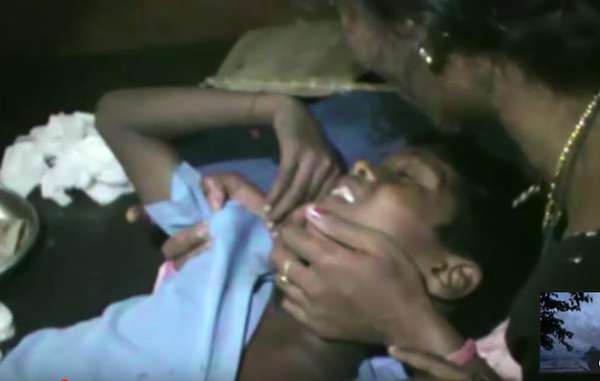
Akash Orang is comforted by his mother after being shot by a park guard. He is now severely disabled. © BBC
Similar policies are used in other parts of the world, notably Kenya, Tanzania and Botswana, among other African countries.
Speaking about his own anti-poaching work in Africa, poaching expert Rory Young from the organization Chengeta said: ”Shoot on sight is stupid. If we had been shooting on sight during this latest sting operation we would have shot a handful of poachers and that would have been the end of it. Every single poacher is an opportunity for information to get more poachers and work your way up the chain to the ringleaders.”
Survival has asked the Special Rapporteur to clarify that shoot on sight violates fundamental rights enshrined in the UN’s Civil and Political Rights Covenant and other international conventions. It also urges the UN to enquire about the policy with the Indian government, and the government of Assam state, where Kaziranga is located.
Shoot on sight is justified on the grounds that it helps to deter poachers. However, there have been several recent cases of guards and officials at Kaziranga being arrested for involvement in the illegal wildlife trade themselves.
Survival International is leading the fight against these abuses, and calling for a new conservation model that respects tribal peoples. Targeting tribal people diverts action away from tackling the true poachers – criminals conspiring with corrupt officials. Targeting tribal people harms conservation.
Survival’s Director Stephen Corry said: “If any other industry was guilty of this level of human rights abuses, there would be an international outcry. Why the silence when conservationists are involved? Torture and extrajudical killing is never justified – the law is clear on this. Some people think that the death of innocents is justified, that ‘collateral damage’ is necessary in the fight against poaching. We ask them, where is your humanity? Of course, there’s a racist element at play here: Shoot on sight policies would be unthinkable in North America or Europe.”
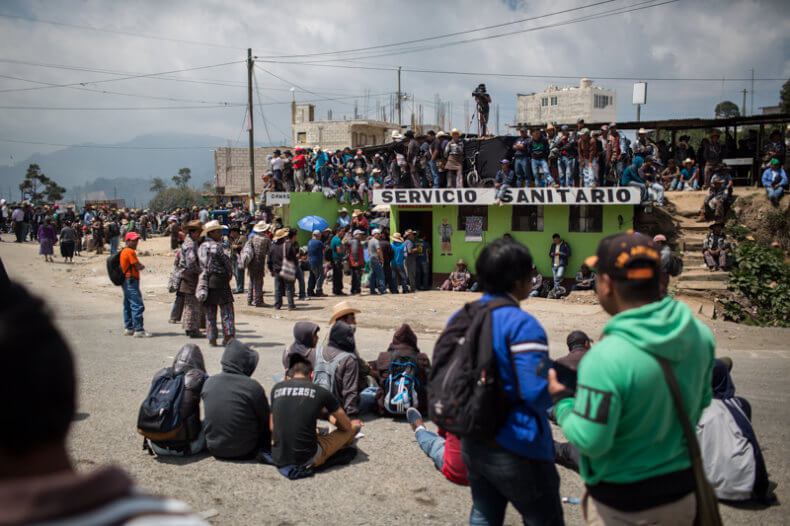
by Deep Green Resistance News Service | Feb 26, 2017 | Indigenous Autonomy, Obstruction & Occupation
Featured image: Protesters gathered at Los Encuentros, by Anna Watts
by Anna Watts / Intercontinental Cry
Indigenous communities across Guatemala have brought the country to a standstill for the second day in a row. Blockading major crossroads and highways, the nationwide peaceful demonstrations are protesting against the Guatemalan congress’s rejection of a constitutional reform that would legally recognize indigenous justice as part of the country’s judicial system.
An estimated 60 percent, or more than 6 million inhabitants, make up Guatemala’s population (IWGIA). Yet indigenous systems of justice, wherein local authorities rule on community issues, have been looked down upon by a country that continues to hugely discriminate against its majority indigenous population. The reforms face opposition from conservatives and major businesses that control most of Guatemala’s land and economy. Although many of these business interests campaigned against the reforms under the guise of fearing “legal confusion,” indigenous activists and leaders at the protests describe the opposition as deriving from a fear of losing any of their elite power to those who have been oppressed and exploited for centuries–Indigenous Peoples.
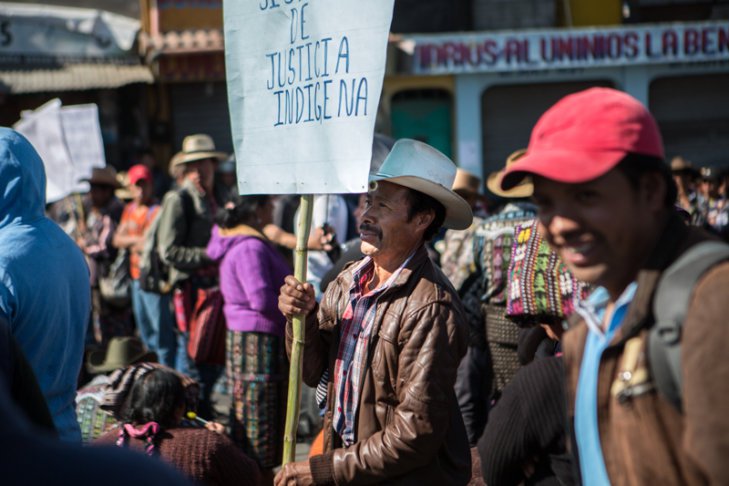
Photo: Anna Watts
At Los Encuentros, one of the most important crossroads between major cities located along the Pan-American Highway, thousands of indigenous people of the Sololá region gathered to participate in the blockades. Carrying handmade signs and led by their respective indigenous leaders, community groups unloaded from packed cargo trucks and chicken buses, carrying ready-made lunches to last through a full day of protesting.
By 8:30 AM, every tienda, comedor, and tortilla stand had been closed down and locked up, a rare sight for the ever-bustling highway hub. The majority indigenous city of Sololá was deserted; not a car in sight nor shop windows open. Pick-up trucks and makeshift blockades of boulders and large tree branches cut off traffic between smaller communities surrounding Lake Atitlán.
Protesters organized and coordinated solely by means of meetings and phone calls between indigenous community leaders. Use of Internet or social media to communicate and gain protest support was entirely avoided out of fear of vulnerability and tracking by police and those opposing the reforms. This distrust was reflected in weak media coverage of the protests; in spite of the thousand plus standing in solidarity at Los Encuentros, only one reporter from a local agency showed up with a small video camera.
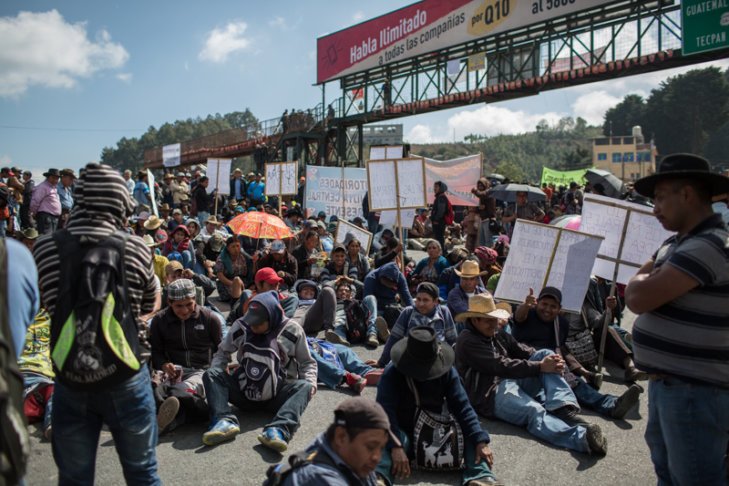
Photo: Anna Watts








